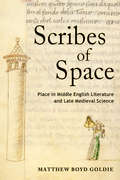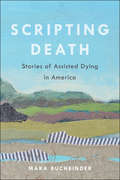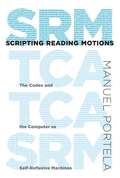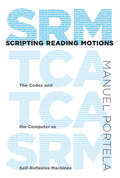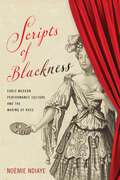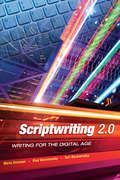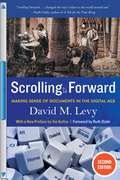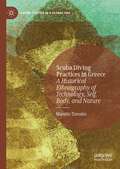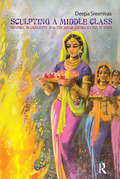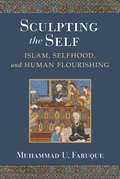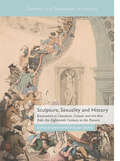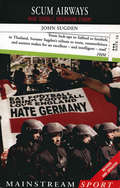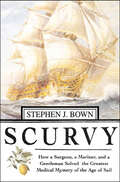- Table View
- List View
Scribble Scribble: Notes on the Media
by Nora EphronAddresses, essays and lectures by Ephron on mass media today.
Scribes of Space: Place in Middle English Literature and Late Medieval Science
by Matthew Boyd GoldieScribes of Space posits that the conception of space—the everyday physical areas we perceive and through which we move—underwent critical transformations between the thirteenth and fifteenth centuries. Matthew Boyd Goldie examines how natural philosophers, theologians, poets, and other thinkers in late medieval Britain altered the ideas about geographical space they inherited from the ancient world. In tracing the causes and nature of these developments, and how geographical space was consequently understood, Goldie focuses on the intersection of medieval science, theology, and literature, deftly bringing a wide range of writings—scientific works by Nicole Oresme, Jean Buridan, the Merton School of Oxford Calculators, and Thomas Bradwardine; spiritual, poetic, and travel writings by John Lydgate, Robert Henryson, Margery Kempe, the Mandeville author, and Geoffrey Chaucer—into conversation. This pairing of physics and literature uncovers how the understanding of spatial boundaries, locality, elevation, motion, and proximity shifted across time, signaling the emergence of a new spatial imagination during this era.
Scripting Addiction: The Politics of Therapeutic Talk and American Sobriety
by E. Summerson CarrGaming the language of addiction treatmentScripting Addiction takes readers into the highly ritualized world of mainstream American addiction treatment. It is a world where clinical practitioners evaluate how drug users speak about themselves and their problems, and where the ideal of "healthy" talk is explicitly promoted, carefully monitored, and identified as the primary sign of therapeutic progress. The book explores the puzzling question: why do addiction counselors dedicate themselves to reconciling drug users' relationship to language in order to reconfigure their relationship to drugs?To answer this question, anthropologist Summerson Carr traces the charged interactions between counselors, clients, and case managers at "Fresh Beginnings," an addiction treatment program for homeless women in the midwestern United States. She shows that shelter, food, and even the custody of children hang in the balance of everyday therapeutic exchanges, such as clinical assessments, individual therapy sessions, and self-help meetings. Acutely aware of the high stakes of self-representation, experienced clients analyze and learn to effectively perform prescribed ways of speaking, a mimetic practice they call "flipping the script."As a clinical ethnography, Scripting Addiction examines how decades of clinical theorizing about addiction, language, self-knowledge, and sobriety is manifested in interactions between counselors and clients. As an ethnography of the contemporary United States, the book demonstrates the complex cultural roots of the powerful clinical ideas that shape therapeutic transactions—and by extension administrative routines and institutional dynamics—at sites such as "Fresh Beginnings."
Scripting Death: Stories of Assisted Dying in America (California Series in Public Anthropology #50)
by Mara BuchbinderHow the legalization of assisted dying is changing our lives. Over the past five years, medical aid-in-dying (also known as assisted suicide) has expanded rapidly in the United States and is now legally available to one in five Americans. This growing social and political movement heralds the possibility of a new era of choice in dying. Yet very little is publicly known about how medical aid-in-dying laws affect ordinary citizens once they are put into practice. Sociological studies of new health policies have repeatedly demonstrated that the realities often fall short of advocacy visions, raising questions about how much choice and control aid-in-dying actually affords. Scripting Death chronicles two years of ethnographic research documenting the implementation of Vermont’s 2013 Patient Choice and Control at End of Life Act. Author Mara Buchbinder weaves together stories collected from patients, caregivers, health care providers, activists, and legislators to illustrate how they navigate aid-in-dying as a new medical frontier in the aftermath of legalization. Scripting Death explains how medical aid-in-dying works, what motivates people to pursue it, and ultimately, why upholding the "right to die" is very different from ensuring access to this life-ending procedure. This unprecedented, in-depth account uses the case of assisted death as an entry point into ongoing cultural conversations about the changing landscape of death and dying in the United States.
Scripting Feminist Ethics in Teacher Education (Education)
by Michelle Forrest Linda WheeldonWhat is the value and place of feminist teaching in common schooling and teacher education? In an open style of writing in philosophy of education, the authors combine original dramatized case studies and allegorical, first-person narratives to analyze key concepts for teachers in relation to radical feminist consciousness-raising. They examine values relativism as antithetical to “good” teaching; the history and practice of feminist consciousness-raising as corrective to the dominant model of moral deliberation in professional ethics; youth cyber-bullying as an example of Italian feminist philosopher Adriana Caverero’s claim that ‘horror is the face of woman;’ and the value of paradox, contradiction and myth in counter-balancing material-realist certainty in teaching, research, and policy-making in public education. Supplements to the five chapters offer additional ideas for introducing feminist teaching practices, through discussion and performance, into professional ethics for pre- and in-service teacher education. This book is published in English. - Dans un style original et fascinant, les auteures jettent la lumière sur l’histoire, le processus et la valeur de la sensibilisation radicale au féminisme à l’intention des formateurs en enseignement et des enseignants féministes. Elles se penchent sur de graves incidents qui se déroulent de nos jours dans les salles de classe. Caractérisés par le relativisme des valeurs, les jugements précipités, la constatation de vulnérabilité, la cyberintimidation et le besoin de contrer le déterminisme dans l’éducation des enseignants et dans la recherche, ces incidents sont analysés à partir de concepts clés formulés par des philosophes et des théoriciens féministes. Mariant récits personnels, dramatisation, allusions littéraires et reconstructions philosophiques, les auteures formulent des analyses et remettent en question la place de l’aspect personnel dans la responsabilité éthique de l’enseignant en matière de délibérations morales dans des classes pluralistes. Ce livre pourra intéresser les éducateurs qui aident les enseignants en formation à développer les capacités et la sensibilité nécessaires pour assumer l’autorité qui leur revient en classe. Les questions éthiques qui sont soulevées ont aussi des répercussions sur l’enseignement de l’éthique professionnelle dans d’autres disciplines axées sur le travail social. Cette oeuvre unique va au coeur des pires craintes et présomptions des enseignants, et propose une nouvelle approche visant l’analyse des études de cas en philosophie de l’éducation. Ce livre est publié en anglais.
Scripting Media
by Frank Barnas Marie BarnasBringing together professional standards, practices, and jargon from across the industry, Scripting Media provides a complete overview of writing for divergent forms of media. While some forms of media writing have been honed and standardized over generations, others demand new ways of thinking and collaborating. Covering traditional forms of scriptwriting, such as news, advertising, and film scripting, as well as newer and more emerging areas of social media and virtual reality, this book is designed to prepare readers for the varying formats, styles, and techniques specific to each medium. Each chapter contains a list of key terms, an historical overview of the area, and technical specifications for students to be aware of. Exercises, essay prompts, and online links help reinforce students’ knowledge and provide avenues for private study. Written in an accessible and engaging style by two renowned media practitioners, authors, and teachers, Scripting Media is essential reading for students approaching media writing for the first time.
Scripting Media
by Frank Barnas Marie BarnasBringing together professional standards, practices, and jargon from across the industry, Scripting Media provides a complete overview of writing for divergent forms of media.While some forms of media writing have been honed and standardized over generations, others demand new ways of thinking and collaborating. Covering traditional forms of scriptwriting, such as news, advertising, and film scripting, as well as newer and more emerging areas of social media and virtual reality, this book is designed to prepare readers for the varying formats, styles, and techniques specific to each medium. Each chapter contains a list of key terms, an historical overview of the area, and technical specifications for students to be aware of. Exercises, essay prompts, and online links help reinforce students’ knowledge and provide avenues for private study.Written in an accessible and engaging style by two renowned media practitioners, authors, and teachers, Scripting Media is essential reading for students approaching media writing for the first time.
Scripting Reading Motions: The Codex and the Computer as Self-Reflexive Machines
by Manuel PortelaIn Scripting Reading Motions, Manuel Portela explores theexpressive use of book forms and programmable media in experimental works of both print andelectronic literature and finds a self-conscious play with the dynamics of reading and writing. Portela examines a series of print and digital works by Johanna Drucker, Mark Z. Danielewski, RuiTorres, Jim Andrews, and others, for the insights they yield about the semiotic and interpretiveactions through which readers produce meaning when interacting with codes. Analyzing these works asembodiments and simulations of the motions of reading, Portela pays particular attention to the waysin which awareness of eye movements and haptic interactions in both print and electronic media feedsback onto the material and semantic layers of the works. These feedbacks, he argues, sustainself-reflexive loops that link the body of the reader to the embodied work. Readers' haptic actionsand eye movements coinstantiate the object that they are reading. Porteladiscusses typographic and graphic marks as choreographic notations for reading movements; examinesdigital recreations of experimental print literary artifacts; considers reading motions in kineticand generated texts; analyzes the relationship of bibliographic, linguistic, and narrative coding inDanielewski's novel-poem, Only Revolutions; and describes emergent meanings ininteractive textual instruments. The expressive use of print and programmable media, Portela shows,offers a powerful model of the semiotic, interpretive, and affective operations embodied in readingprocesses.
Scripting Reading Motions: The Codex and the Computer as Self-Reflexive Machines (The\mit Press Ser.)
by Manuel PortelaAn exploration of what experimental literature in both print and programmable media tells us about the act of reading.In Scripting Reading Motions, Manuel Portela explores the expressive use of book forms and programmable media in experimental works of both print and electronic literature and finds a self-conscious play with the dynamics of reading and writing. Portela examines a series of print and digital works by Johanna Drucker, Mark Z. Danielewski, Rui Torres, Jim Andrews, and others, for the insights they yield about the semiotic and interpretive actions through which readers produce meaning when interacting with codes. Analyzing these works as embodiments and simulations of the motions of reading, Portela pays particular attention to the ways in which awareness of eye movements and haptic interactions in both print and electronic media feeds back onto the material and semantic layers of the works. These feedbacks, he argues, sustain self-reflexive loops that link the body of the reader to the embodied work. Readers' haptic actions and eye movements coinstantiate the object that they are reading.Portela discusses typographic and graphic marks as choreographic notations for reading movements; examines digital recreations of experimental print literary artifacts; considers reading motions in kinetic and generated texts; analyzes the relationship of bibliographic, linguistic, and narrative coding in Danielewski's novel-poem, Only Revolutions; and describes emergent meanings in interactive textual instruments. The expressive use of print and programmable media, Portela shows, offers a powerful model of the semiotic, interpretive, and affective operations embodied in reading processes.Important Notice: The digital edition of this book is missing some of the images found in the physical edition.
Scripting the Environment: Oil, Democracy and the Sands of Time and Space (Palgrave Studies in Media and Environmental Communication)
by Geo TakachThis volume explores how to engage audiences both beyond and within the academy more deeply in environmental research through arts-based forms. It builds on a multi-pronged case study of scripts for documentary film, audio-visual and stage formats, focusing on how the identity of a place is constructed and contested in the face of environmental concerns around fossil-fuel extraction in a globalized, visual society--and specifically on the rising, international public-relations war over Alberta’s stewardship of the tar sands. Each script is followed by discussion of the author’s choices of initiating idea, research sources, format, voices, world of the story, structure and visual style, and other notes on the convergence of synthesis, analysis and (re)presentation in the script. Included are lively analysis and commentary on screenwriting and playwriting theory, the creation and dissemination of the scripts, and reflections to ground a proposed framework for writing eco-themed scripts for screen, audio-visual and stage formats.
Scripts of Blackness: Early Modern Performance Culture and the Making of Race (RaceB4Race: Critical Race Studies of the Premodern)
by Noémie NdiayeScripts of Blackness shows how the early modern mass media of theatre and performance culture at-large helped turn blackness into a racial category, that is, into a type of difference justifying emerging social hierarchies and power relations in a new world order driven by colonialism and capitalism.In this book, Noémie Ndiaye explores the techniques of impersonation used by white performers to represent Afro-diasporic people in England, France, and Spain in the sixteenth and seventeenth centuries, using a comparative and transnational framework. She reconstructs three specific performance techniques—black-up (cosmetic blackness), blackspeak (acoustic blackness), and black dances (kinetic blackness)—in order to map out the poetics of those techniques, and track a number of metaphorical strains that early modern playtexts regularly associated with them. Those metaphorical strains, the titular scripts of blackness of this book, operated across national borders and constituted resources, as they provided spectators and participants with new ways of thinking about the Afro-diasporic people who lived or could/would ultimately live in their midst.Those scripts were often gendered and hinged on notions of demonization, exclusion, exploitation, animalization, commodification, sexualization, consensual enslavement, misogynoir, infantilization, and evocative association with other racialized minorities. Scripts of Blackness attempts to grasp the stories that Western Europeans told themselves through performative blackness, and the effects of those fictions on early modern Afro-diasporic subjects.
Scripts of Blackness: Race, Cultural Nationalism, and U.S. Colonialism in Puerto Rico
by Isar P GodreauThe geopolitical influence of the United States informs the processes of racialization in Puerto Rico, including the construction of black places. In Scripts of Blackness, Isar P. Godreau explores how Puerto Rican national discourses about race--created to overcome U.S. colonial power--simultaneously privilege whiteness, typecast blackness, and silence charges of racism. Based on an ethnographic study of the barrio of San Antón in the city of Ponce, Scripts of Blackness examines institutional and local representations of blackness as developing from a power-laden process that is inherently selective and political, not neutral or natural. Godreau traces the presumed benevolence or triviality of slavery in Puerto Rico, the favoring of a Spanish colonial whiteness (under a hispanophile discourse), and the insistence on a harmonious race mixture as discourses that thrive on a presumed contrast with the United States that also characterize Puerto Rico as morally superior. In so doing, she outlines the debates, social hierarchies, and colonial discourses that inform the racialization of San Antón and its residents as black. Mining ethnographic materials and anthropological and historical research, Scripts of Blackness provides powerful insights into the critical political, economic, and historical context behind the strategic deployment of blackness, whiteness, and racial mixture.
Scriptwriting 2.0: Writing for the Digital Age
by Marie DrennanOnline media is and will continue to be at the forefront of entertainment; this book introduces readers to this new world and helps them create good content for it. It is a compact, practical guide for those who want to explore scriptwriting for the digital age while also learning essential skills and techniques central to new media writing. Scriptwriting 2.0 contains advice on writing both short- and long-form webisodes as part of a series, as well as standalone pieces. It then goes beyond the writing process to discuss revising, production, promotion and copyright. It is written in a friendly, readable and jargon-free style and includes real-world examples from successful series and a sample script. Readers can access full episodes of the two series discussed at length as well as samples from several other web series.
Scrolling Forward, Second Edition: Making Sense of Documents in the Digital Age
by David M. Levy Ruth OzekiA fascinating, insightful, and wonderfully written exploration of the document.Like Henry Petroski’s The Pencil, David Levy’s Scrolling Forward takes a common, everyday object, the document, and illuminates what it reveals about us, both in the past and in the digital age.We are surrounded daily by documents of all kinds-letters and credit card receipts, business memos and books, television images and web pages-yet we rarely stop to reflect on their significance. Now, in this period of digital transition, our written forms as well as our reading and writing habits are being disturbed and transformed by new technologies and practices.An expert on information and written forms, and a former researcher for the document pioneer Xerox, Levy masterfully navigates these concerns, offering reassurance while sharing his own excitement about many of the new kinds of emerging documents. He demonstrates how today’s technologies, particularly the personal computer and the World Wide Web, are having analogous effects to past inventions-such as paper, the printing press, writing implements, and typewriters-in shaping how we use documents and the forms those documents take. Scrolling Forward lets us see the continuity between the written forms of today and those of the past.Skyhorse Publishing, as well as our Arcade imprint, are proud to publish a broad range of books for readers interested in history--books about World War II, the Third Reich, Hitler and his henchmen, the JFK assassination, conspiracies, the American Civil War, the American Revolution, gladiators, Vikings, ancient Rome, medieval times, the old West, and much more. While not every title we publish becomes a New York Times bestseller or a national bestseller, we are committed to books on subjects that are sometimes overlooked and to authors whose work might not otherwise find a home.
Scrolling Forward: Making Sense of Documents in the Digital Age
by David M. LevyWe are surrounded by documents of all kinds, from receipts to letters, business memos to books, yet we rarely stop to reflect on their significance. Now, in this period of digital transition, our written forms as well as out reading and writing habits are being questioned and transformed by new technologies ad practices. What is the future of the book? Is paper about to disappear? With the Internet and World Wide Web, what will happen to libraries, copyright and education? Starting with a simple deli lunch receipt, SCROLLING FORWARD examines documents of all kinds from the perspectives of culture, history, and technology in order to show how they can work and what they say about us and the values we carry into the new age.
Scrolling Forward: Making Sense of Documents in the Digital Age
by David M. Levy Ruth OzekiLike Henry Petroski’s The Pencil, David Levy’s Scrolling Forward takes a common, everyday object, the document, and illuminates what it reveals about us, both in the past and in the digital age.We are surrounded daily by documents of all kinds-letters and credit card receipts, business memos and books, television images and web pages-yet we rarely stop to reflect on their significance. Now, in this period of digital transition, our written forms as well as our reading and writing habits are being disturbed and transformed by new technologies and practices.An expert on information and written forms, and a former researcher for the document pioneer Xerox, Levy masterfully navigates these concerns, offering reassurance while sharing his own excitement about many of the new kinds of emerging documents. He demonstrates how today’s technologies, particularly the personal computer and the World Wide Web, are having analogous effects to past inventions-such as paper, the printing press, writing implements, and typewriters-in shaping how we use documents and the forms those documents take. Scrolling Forward lets us see the continuity between the written forms of today and those of the past.
Scrolling Forward: Making Sense of Documents in the Digital Age (Second Edition)
by David M. LevyScrolling Forward takes a common, everyday object--the document--and illuminates what it reveals about us, both in the past and as we move into the digital age.
Scrutinising Elites and Schooling in Post-Communist Poland: Globalisation, European Integration, Socialist Heritage, and Tradition (Routledge Research in Education)
by Alexandra Margaret DunwillThis book offers new insights and methodological tools to improve our understandings of how prestigious schools in Poland navigate the major political, social and cultural crosscurrents. The range of choice for elite schooling in Poland has expanded during its post-communist transformation. However, while elite education in countries such as the US, Australia, UK, France, and Switzerland has been extensively studied, post-communist countries have been largely neglected. This book explores the emergence of such schools within a context influenced by a range of different and often conflicting social forces. In doing so, the study elucidates how the socio-historical processes since 1989 diversified Poland’s egalitarian education system and facilitated the emergence of schools for elites. The book demonstrates that social and political changes in Poland triggered the emergence of new elites with different political and social outlooks, leading to a variety of types of elite schools that reflect and reproduce the elites’ positions and idiosyncrasies. A bespoke theoretical arrangement scrutinises extant and generated data from elite schools’ websites, online readers’ forums, and interviews with elite school principals. The book contributes new insights into elite schools in Central and Eastern European (CEE) countries, enriching the existing body of knowledge on elites and elite schools around the world. It will be of interest to researchers and postgraduate students investigating elite education, sociology of education, education policy, and education and international development.
Scuba Diving Practices in Greece: A Historical Ethnography of Technology, Self, Body, and Nature (Leisure Studies in a Global Era)
by Manolis TzanakisThis book provides a historical-sociological analysis of recreational scuba diving practices. Starting from a national case study, Greece, the book analyzes the gradually evolving global institutional arrangements of this version of underwater recreational activities. Based on the author’s experience as a former diving instructor and on an historical and sociological research of scuba diving in Greece, the book examines the stages of institutionalization of scuba diving as a leisure practice on a global scale, from 1945 to the present day. It combines two traditions: the phenomenological approach of underwater multisensory embodied experience and tourism studies. The two main research questions that the project answers are (a) how scuba diving has historically been shaped as a leisure activity, (b) how has underwater experience been conceptually shaped as a leisure activity. This case is an excellent example for exploring the relationship between society, technology, body and modern practices of self in the late modernity world, under a phenomenological and historical perspective.
Sculpted Ambiances in Africana Landscape
by George Joshua OrwelSculpted Ambiances in Africana Landscape centers on ambiance as it affects the expanded sculptural field, particularly filling a gap in aesthetics left by a lack of focus on sculptures and installations in the Africana world and elsewhere.This book differentiates ambiance from other affective states and emotions and explores its production. It provides an introduction to the history of ambiance and vividly demonstrates, through immersive and experiential writing, how ambiance manifests in different artistic situations and social settings. The book considers the neglected and unique importance of sculptural ambiance to the history of Africana visual culture, and what these works mean in terms of their social, historical, cultural, political, and ecological imagination of space. The book is written in an episodic style and begins with a description of an image before presenting an analysis of the artist’s style and staging for ambient experience.This book will benefit college and university students; scholars of art, architecture, aesthetics, philosophy, geography, anthropology, and sociology; and curators and galleries.
Sculpting the Middle Class: History, Masculinity and the Amar Chitra Katha
by Deepa SreenivasThis book is an analysis of the Amar Chitra Katha genre, historical comic-books that capture and promote a middle class masculine identity, as culture became the new site for right-wing hegemonic politics in India over the last 4 decades of the 20th century.
Sculpting the Self: Islam, Selfhood, and Human Flourishing
by Muhammad FaruqueSculpting the Self addresses “what it means to be human” in a secular, post-Enlightenment world by exploring notions of self and subjectivity in Islamic and non-Islamic philosophical and mystical thought. Alongside detailed analyses of three major Islamic thinkers (Mulla ?adra, Shah Wali Allah, and Muhammad Iqbal), this study also situates their writings on selfhood within the wider constellation of related discussions in late modern and contemporary thought, engaging the seminal theoretical insights on the self by William James, Jean-Paul Sartre, and Michel Foucault. This allows the book to develop its inquiry within a spectrum theory of selfhood, incorporating bio-physiological, socio-cultural, and ethico-spiritual modes of discourse and meaning-construction. Weaving together insights from several disciplines such as religious studies, philosophy, anthropology, critical theory, and neuroscience, and arguing against views that narrowly restrict the self to a set of cognitive functions and abilities, this study proposes a multidimensional account of the self that offers new options for addressing central issues in the contemporary world, including spirituality, human flourishing, and meaning in life. This is the first book-length treatment of selfhood in Islamic thought that draws on a wealth of primary source texts in Arabic, Persian, Urdu, Greek, and other languages. Muhammad U. Faruque’s interdisciplinary approach makes a significant contribution to the growing field of cross-cultural dialogue, as it opens up the way for engaging premodern and modern Islamic sources from a contemporary perspective by going beyond the exegesis of historical materials. He initiates a critical conversation between new insights into human nature as developed in neuroscience and modern philosophical literature and millennia-old Islamic perspectives on the self, consciousness, and human flourishing as developed in Islamic philosophical, mystical, and literary traditions.
Sculpture, Sexuality and History: Encounters in Literature, Culture and the Arts from the Eighteenth Century to the Present (Genders and Sexualities in History)
by Jana Funke Jen GroveThis book investigates the wide-ranging connections between sculpture, sexuality, and history in Western culture from the eighteenth century to the present. Sculpture has offered a privileged site for the articulation of sexual experience and the formation of sexual knowledge. As historical objects, sculptures also draw attention to the different ways in which knowledge about sexuality is facilitated through an engagement with the past. Bringing together contributors from across disciplines, including art history, classics, film studies, gender studies, history, literary studies, museum studies, queer theory and reception studies, the volume presents original readings of sculptural art in relation to antiquarianism, aesthetics, collecting cultures, censorship and obscenity, psychoanalysis, sexology, and the experience and regulation of museum spaces. It examines how sculptural encounters were imagined and articulated in literature, painting, film and science. As a whole, the book opens up a new understanding of the ways in which sculptures, as real or imagined objects, have fundamentally shaped approaches to and receptions of the past in relation to sex, gender and sexuality.Chapters 8 and 10 of this book are available open access under a CC BY 4.0 license at link.springer.com.
Scum Airways: Inside Football's Underground Economy
by John SugdenFootball is big business and it doesn't come much bigger than Manchester United – commercial giants and the richest club in the world. But in the shadow of Old Trafford a black economy is growing to rival the commercial power of the official sales channels. Scum Airways is an inside investigation of the Manchester grafters – touts, black marketeers and shady dealers – who, led by characters like 'Big Tommy', have come up with a remarkably successful money-making venture: Scum Airways. With the expansion of the Champions League came the opportunity for the grafters to move from ticket touting and producing 'unofficial' replica kits into the independent travel business. International Travel is the company for those who, through choice or because of their police records prohibit them, do not travel with the official clubs. Their customers include many 'straight' supporters of Leeds United, arch-rivals of Man U, but Tommy's core clients are the 'Lads' - die-hard 30-something football hooligans. Scum Airways follows the exploits and adventures of Big Tommy and his team of grafters as they continue to build their empire. John Sugden went along for the ride and provides startling insights into professional football's burgeoning black economy. From Munich to Madrid, Amsterdam to Bangkok, through to the streets and bars of Toyko and Sapporo during the 2002 World Cup, and beyond, Scum Airways reveals the dark side of the football business.
Scurvy: How a Surgeon, a Mariner, and a Gentlemen Solved the Greatest Medical Mystery of the Age of Sail
by Stephen J. BownScurvy took a terrible toll in the Age of Sail, killing more sailors than were lost in all sea battles combined. The threat of the disease kept ships close to home and doomed those vessels that ventured too far from port. The willful ignorance of the royal medical elite, who endorsed ludicrous medical theories based on speculative research while ignoring the life-saving properties of citrus fruit, cost tens of thousands of lives and altered the course of many battles at sea. The cure for scurvy ranks among the greatest of human accomplishments, yet its impact on history has, until now, been largely ignored. From the earliest recorded appearance of the disease in the sixteenth century, to the eighteenth century, where a man had only half a chance of surviving the scourge, to the early nineteenth century, when the British conquered scurvy and successfully blockaded the French and defeated Napoleon, Scurvy is a medical detective story for the ages, the fascinating true story of how James Lind (the surgeon), James Cook (the mariner), and Gilbert Blane (the gentleman) worked separately to eliminate the dreaded affliction. Scurvy is an evocative journey back to the era of wooden ships and sails, when the disease infiltrated every aspect of seafaring life: press gangs "recruit" mariners on the way home from a late night at the pub; a terrible voyage in search of riches ends with a hobbled fleet and half the crew heaved overboard; Cook majestically travels the South Seas but suffers an unimaginable fate. Brimming with tales of ships, sailors, and baffling bureaucracy, Scurvy is a rare mix of compelling history and classic adventure story.

